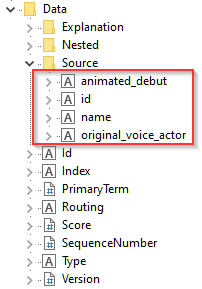Introduction
NEST is a convenient way to access Elasticsearch data. List & Label can easily be bound to NEST result objects, which enables to bind to data from Elasticsearch clusters.
Implementation
As the response object is rather complex, you should set a couple of properties on an explicitly generated ObjectDataProvider object in order to present the user with just what is required. A minimal example (using the data from this example) might be:
using (ListLabel LL = new ListLabel())
{
// retrieve data from Elasticsearch
var response = ConnectionToES.EsClient().Search<DocumentAttributes>(s => s
.Index("disney")
.From(0)
.Size(1000)
.Query(q => q.MatchAll()));
// create ObjectDataProvider with minimal clutter
ObjectDataProvider provider = new ObjectDataProvider(response.Hits)
{
// flatten structure to the minimal amount required
MaximumRecursionDepth = 1,
// assign a nice, descriptive name to the main data table
RootTableName = "Data"
};
// register event of the ObjectDataProvider to engage into its parsing
provider.HandleEnumerableProperty += Provider_HandleEnumerableProperty;
// bind to data and call the Designer
LL.DataSource = provider;
LL.Design();
}
Using the event HandleEnumerableProperty of the List & Label ObjectDataProvider provides access to the assigned object structure:
private void Provider_HandleEnumerableProperty(object sender, HandleEnumerablePropertyEventArgs e)
{
// just don't follow any paths
e.CancelRecursion = true;
}
Result
The data is then available from the Data > Source folder in the Designer:
and can easily be used from there as simple table:

If you want to further strip this down, you may create a simplified, typed object from the results of course as well.
